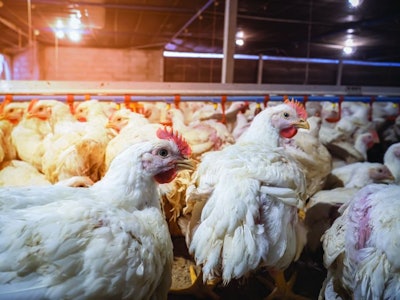
When broilers experience heat stress, feeding the correct diet can help to support changes made to ventilation, cooling systems and stocking density in reducing the impact of high temperatures. Importantly, nutrition can play a vital role in protecting broilers from the effects of heat stress when making structural changes to poultry houses is neither affordable or practical.
There are three key areas of feed formulation that need to be considered to protect broiler flocks during times of heat stress.
1. Energy
As feed intake decreases during heat stress, it is important to ensure sufficient energy for the bird.
Functionally, this means increasing energy density by increasing oil in relation to carbohydrates. Increasing the oil to carbohydrate ratio in feeds also reduces the heat increment of the diet, as fats generate less heat when they are digested and metabolized compared to carbohydrates. This then reduces the level of excess heat to dissipate when the ambient temperature is already high.
Heat stress also causes shifts in a bird’s energy metabolism, which has been associated with increased fat deposition, oxidative stress and meat quality issues.
The mitochondria, as the powerhouse of the cell, struggle to maintain creation of adenosine triphosphate (ATP) as an energy source while minimizing levels of oxidants. Dietary inclusion of products that support mitochondrial ATP production can benefit broilers in heat stress. Products containing guanidinoacetic acid, a precursor of creatine, for example, improve the efficiency of mitochondrial energy metabolism. Recent research has shown that the addition of guanidinoacetic acid in the diets of birds reared at above optimal temperatures improves feed efficiency and reduces signs of heat stress.
2. Protein
The heat increment of the diet is an important consideration when formulating feed for broilers in hot weather. Protein is the macronutrient with the highest heat increment and should be limited as much as possible.
The easiest way to reduce crude protein in the diet is to formulate based on the standardized ileal digestible (SID) amino acid requirements for the broiler. This can be implemented by utilizing databases listing the SID values for raw ingredients and SID amino acid recommendation tools.
Formulating diets to meet SID amino acid requirements not only reduces crude protein and heat increment but can also cut feed costs by decreasing inclusion levels of expensive high protein raw ingredients.
Heat stressed broilers also have an impairment in digestive function as blood moves away from the gut towards the peripheries for cooling. A shift from protein bound amino acids to pure forms of supplemental amino acids improves digestibility of the diet and may, in turn, improve nitrogen utilization in broilers, especially when reared in high temperatures.
Another benefit of utilizing additional amino acids is that it allows for precise dosing of essential amino acids that play functional roles beyond growth. For example, the sulfur amino acids, methionine and cysteine (Met+Cys) are precursors for the synthesis of glutathione, the body’s most powerful antioxidant system.
Sufficient dietary SID Met+Cys is essential for maintaining the glutathione pool and preventing oxidative stress.
Recent studies have shown that any limitation in SID Met+Cys can limit the antioxidant pool. There has been debate about whether the source of supplemental Met as DL-Met or methionine hydroxy analogue (MHA) can affect the antioxidant pool. However, recent studies have shown no major differences between sources in relation to growth or antioxidant capacity if the relative bioavailability of DL-Met to MHA of 100:75 on an equimolar basis (100:65 on a product basis) is utilized as recommended by the European Food and Drug Administration in 2018 (doi.10.2903/j.efsa.2018.5198).

3. Gut health support
Broilers’ gastrointestinal function is greatly impaired during heat stress, and nutrient uptake decreases. This leads to increases in nitrogen in the litter which can negatively impact air quality as well as increase the risk of footpad lesions.
Gut integrity is also weakened during heat stress. This leads to translocation of bacteria and immune system stimulation, reducing growth and, in more severe cases, results in disease outbreaks and increased mortality.
Gut health support is vital to support a flock through heat stress periods. Probiotics have been shown to improve gut integrity and thereby prevent growth performance losses during heat stress. Water applications of probiotics, in particular, can help to ensure gut health support during heat stress where feed intake may be reduced.
In addition to the three areas outlined above, there are other factors that are of high importance when formulating feed for broilers during heat stress. For example, antioxidant vitamin supplementation and electrolyte balance should also be considered.
The content of this article is for information and is not applicable to products marketed or sold in the United States.
















